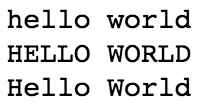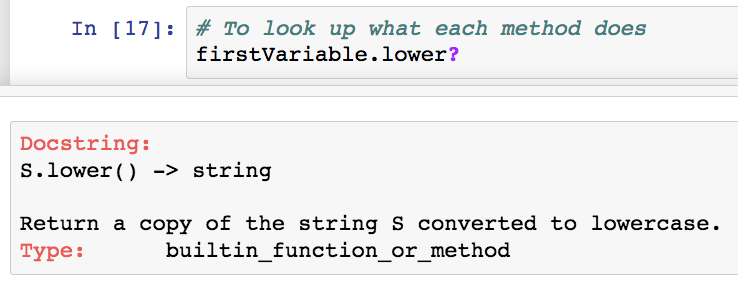mirror of
https://github.com/LCTT/TranslateProject.git
synced 2025-01-16 22:42:21 +08:00
133 lines
4.5 KiB
Markdown
133 lines
4.5 KiB
Markdown
初识 Python:Hello World 和字符串操作
|
||
======
|
||
|
||

|
||
|
||
开始之前,说一下本文中的[代码][1]和[视频][2]可以在我的 GitHub 上找到。
|
||
|
||
那么,让我们开始吧!如果你糊涂了,我建议你在单独的选项卡中打开下面的视频。
|
||
|
||
- [Python 的 Hello World 和字符串操作视频][2]
|
||
|
||
### 开始 (先决条件)
|
||
|
||
首先在你的操作系统上安装 Anaconda (Python)。你可以从[官方网站][4]下载 anaconda 并自行安装,或者你可以按照以下这些 anaconda 安装教程进行安装。
|
||
|
||
- 在 Windows 上安装 Anaconda: [链接[5]
|
||
- 在 Mac 上安装 Anaconda: [链接][6]
|
||
- 在 Ubuntu (Linux) 上安装 Anaconda:[链接][7]
|
||
|
||
### 打开一个 Jupyter Notebook
|
||
|
||
打开你的终端(Mac)或命令行,并输入以下内容([请参考视频中的 1:16 处][8])来打开 Jupyter Notebook:
|
||
|
||
```
|
||
jupyter notebook
|
||
```
|
||
|
||
### 打印语句/Hello World
|
||
|
||
在 Jupyter 的单元格中输入以下内容并按下 `shift + 回车`来执行代码。
|
||
|
||
```
|
||
# This is a one line comment
|
||
print('Hello World!')
|
||
```
|
||
|
||

|
||
|
||
*打印输出 “Hello World!”*
|
||
|
||
### 字符串和字符串操作
|
||
|
||
字符串是 Python 类的一种特殊类型。作为对象,在类中,你可以使用 `.methodName()` 来调用字符串对象的方法。字符串类在 Python 中默认是可用的,所以你不需要 `import` 语句来使用字符串对象接口。
|
||
|
||
```
|
||
# Create a variable
|
||
# Variables are used to store information to be referenced
|
||
# and manipulated in a computer program.
|
||
firstVariable = 'Hello World'
|
||
print(firstVariable)
|
||
```
|
||
|
||

|
||
|
||
*输出打印变量 firstVariable*
|
||
|
||
```
|
||
# Explore what various string methods
|
||
print(firstVariable.lower())
|
||
print(firstVariable.upper())
|
||
print(firstVariable.title())
|
||
```
|
||
|
||

|
||
|
||
*使用 .lower()、.upper() 和 title() 方法输出*
|
||
|
||
```
|
||
# Use the split method to convert your string into a list
|
||
print(firstVariable.split(' '))
|
||
```
|
||
|
||

|
||
|
||
*使用 split 方法输出(此例中以空格分隔)*
|
||
|
||
```
|
||
# You can add strings together.
|
||
a = "Fizz" + "Buzz"
|
||
print(a)
|
||
```
|
||
|
||

|
||
|
||
*字符串连接*
|
||
|
||
### 查询方法的功能
|
||
|
||
对于新程序员,他们经常问你如何知道每种方法的功能。Python 提供了两种方法来实现。
|
||
|
||
1、(在不在 Jupyter Notebook 中都可用)使用 `help` 查询每个方法的功能。
|
||
|
||

|
||
|
||
*查询每个方法的功能*
|
||
|
||
2.(Jupyter Notebook 专用)你也可以通过在方法之后添加问号来查找方法的功能。
|
||
|
||
```
|
||
# To look up what each method does in jupyter (doesnt work outside of jupyter)
|
||
firstVariable.lower?
|
||
```
|
||
|
||

|
||
|
||
*在 Jupyter 中查找每个方法的功能*
|
||
|
||
### 结束语
|
||
|
||
如果你对本文或在 [YouTube 视频][2]的评论部分有任何疑问,请告诉我们。文章中的代码也可以在我的 [GitHub][1] 上找到。本系列教程的第 2 部分是[简单的数学操作][10]。
|
||
|
||
--------------------------------------------------------------------------------
|
||
|
||
via: https://www.codementor.io/mgalarny/python-hello-world-and-string-manipulation-gdgwd8ymp
|
||
|
||
作者:[Michael][a]
|
||
译者:[geekpi](https://github.com/geekpi)
|
||
校对:[wxy](https://github.com/wxy)
|
||
|
||
本文由 [LCTT](https://github.com/LCTT/TranslateProject) 原创编译,[Linux中国](https://linux.cn/) 荣誉推出
|
||
|
||
[a]:https://www.codementor.io/mgalarny
|
||
[1]:https://github.com/mGalarnyk/Python_Tutorials/blob/master/Python_Basics/Intro/Python3Basics_Part1.ipynb
|
||
[2]:https://www.youtube.com/watch?v=JqGjkNzzU4s
|
||
[3]:https://www.youtube.com/watch?v=kApPBm1YsqU
|
||
[4]:https://www.continuum.io/downloads
|
||
[5]:https://medium.com/@GalarnykMichael/install-python-on-windows-anaconda-c63c7c3d1444
|
||
[6]:https://medium.com/@GalarnykMichael/install-python-on-mac-anaconda-ccd9f2014072
|
||
[7]:https://medium.com/@GalarnykMichael/install-python-on-ubuntu-anaconda-65623042cb5a
|
||
[8]:https://youtu.be/JqGjkNzzU4s?t=1m16s
|
||
[9]:data:image/gif;base64,R0lGODlhAQABAAAAACH5BAEKAAEALAAAAAABAAEAAAICTAEAOw==
|
||
[10]:https://medium.com/@GalarnykMichael/python-basics-2-simple-math-4ac7cc928738
|